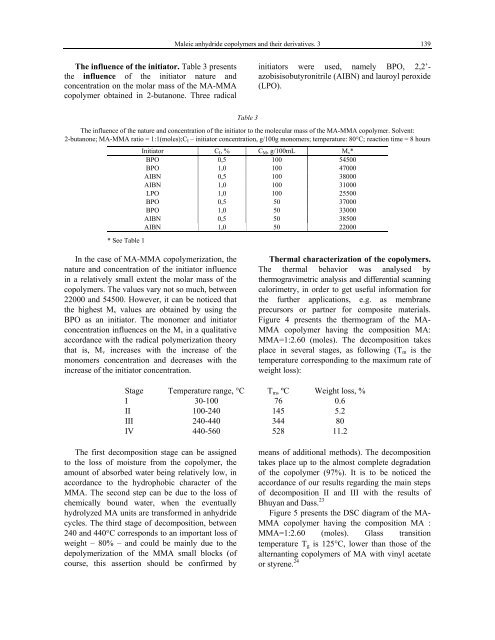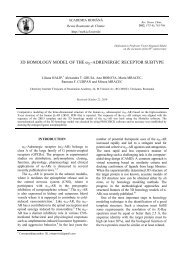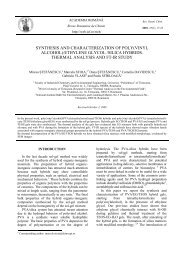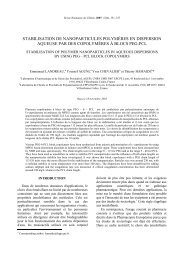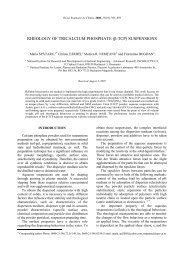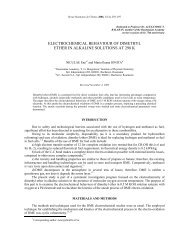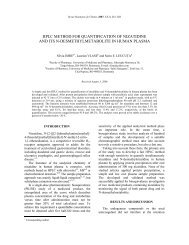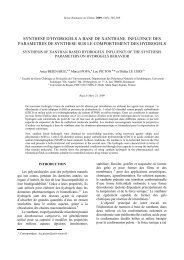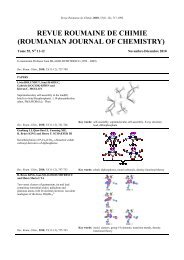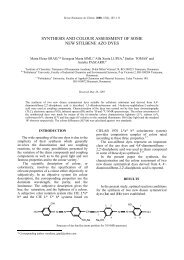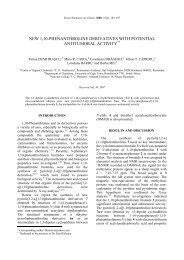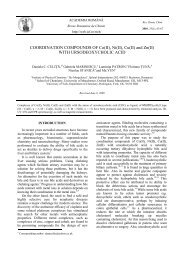synthesis and characterization of maleic anhydride copolymers and ...
synthesis and characterization of maleic anhydride copolymers and ...
synthesis and characterization of maleic anhydride copolymers and ...
Create successful ePaper yourself
Turn your PDF publications into a flip-book with our unique Google optimized e-Paper software.
Maleic <strong>anhydride</strong> <strong>copolymers</strong> <strong>and</strong> their derivatives. 3 139The influence <strong>of</strong> the initiator. Table 3 presentsthe influence <strong>of</strong> the initiator nature <strong>and</strong>concentration on the molar mass <strong>of</strong> the MA-MMAcopolymer obtained in 2-butanone. Three radicalinitiators were used, namely BPO, 2,2’-azobisisobutyronitrile (AIBN) <strong>and</strong> lauroyl peroxide(LPO).Table 3The influence <strong>of</strong> the nature <strong>and</strong> concentration <strong>of</strong> the initiator to the molecular mass <strong>of</strong> the MA-MMA copolymer. Solvent:2-butanone; MA-MMA ratio = 1:1(moles);C I – initiator concentration, g/100g monomers; temperature: 80°C; reaction time = 8 hoursInitiator C I , % C M , g/100mL M v *BPO 0,5 100 54500BPO 1,0 100 47000AIBN 0,5 100 38000AIBN 1,0 100 31000LPO 1,0 100 25500BPO 0,5 50 37000BPO 1,0 50 33000AIBN 0,5 50 38500AIBN 1,0 50 22000* See Table 1In the case <strong>of</strong> MA-MMA copolymerization, thenature <strong>and</strong> concentration <strong>of</strong> the initiator influencein a relatively small extent the molar mass <strong>of</strong> the<strong>copolymers</strong>. The values vary not so much, between22000 <strong>and</strong> 54500. However, it can be noticed thatthe highest M v values are obtained by using theBPO as an initiator. The monomer <strong>and</strong> initiatorconcentration influences on the M v in a qualitativeaccordance with the radical polymerization theorythat is, M v increases with the increase <strong>of</strong> themonomers concentration <strong>and</strong> decreases with theincrease <strong>of</strong> the initiator concentration.Thermal <strong>characterization</strong> <strong>of</strong> the <strong>copolymers</strong>.The thermal behavior was analysed bythermogravimetric analysis <strong>and</strong> differential scanningcalorimetry, in order to get useful information forthe further applications, e.g. as membraneprecursors or partner for composite materials.Figure 4 presents the thermogram <strong>of</strong> the MA-MMA copolymer having the composition MA:MMA=1:2.60 (moles). The decomposition takesplace in several stages, as following (T m is thetemperature corresponding to the maximum rate <strong>of</strong>weight loss):Stage Temperature range, °C T m , ºC Weight loss, %I 30-100 76 0.6II 100-240 145 5.2III 240-440 344 80IV 440-560 528 11.2The first decomposition stage can be assignedto the loss <strong>of</strong> moisture from the copolymer, theamount <strong>of</strong> absorbed water being relatively low, inaccordance to the hydrophobic character <strong>of</strong> theMMA. The second step can be due to the loss <strong>of</strong>chemically bound water, when the eventuallyhydrolyzed MA units are transformed in <strong>anhydride</strong>cycles. The third stage <strong>of</strong> decomposition, between240 <strong>and</strong> 440°C corresponds to an important loss <strong>of</strong>weight – 80% – <strong>and</strong> could be mainly due to thedepolymerization <strong>of</strong> the MMA small blocks (<strong>of</strong>course, this assertion should be confirmed bymeans <strong>of</strong> additional methods). The decompositiontakes place up to the almost complete degradation<strong>of</strong> the copolymer (97%). It is to be noticed theaccordance <strong>of</strong> our results regarding the main steps<strong>of</strong> decomposition II <strong>and</strong> III with the results <strong>of</strong>Bhuyan <strong>and</strong> Dass. 23Figure 5 presents the DSC diagram <strong>of</strong> the MA-MMA copolymer having the composition MA :MMA=1:2.60 (moles). Glass transitiontemperature T g is 125°C, lower than those <strong>of</strong> thealternanting <strong>copolymers</strong> <strong>of</strong> MA with vinyl acetateor styrene. 24


